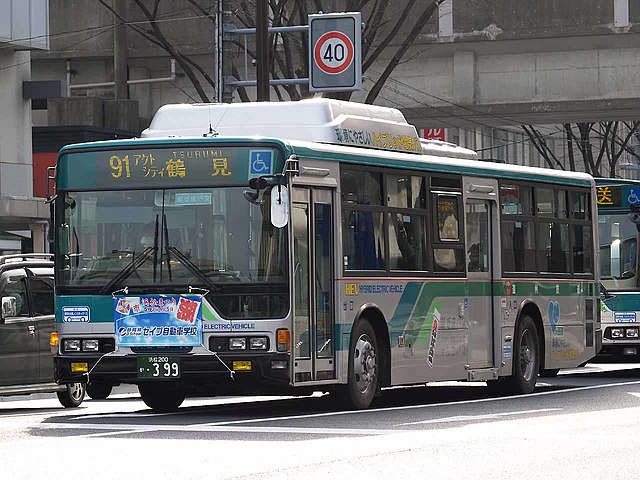Loading AI tools
Bus that combines internal combustion and electric propulsion systems From Wikipedia, the free encyclopedia
A hybrid electric bus is a bus that combines a conventional internal combustion engine propulsion system with an electric propulsion system. These type of buses normally use a Diesel–electric powertrain and are also known as hybrid Diesel–electric buses.

The introduction of hybrid electric vehicles and other green vehicles for purposes of public transport forms a part of sustainable transport schemes.
A hybrid electric bus may have either a parallel powertrain (e.g., Volvo B5LH)[1][2] or a series powertrain (e.g., some versions of the Alexander Dennis Enviro400 MMC).[3] Since 2003, Allison Transmission has produced dual-mode hybrid drive units which take the place of a conventional transmission, mostly for transit buses in North America; as the name implies, it is able to switch between series and parallel modes.[4][5]
A plug-in hybrid school bus effort began in 2003 in Raleigh, NC,[6] when Advanced Energy began working between districts across the country and manufacturers to understand the needs of both. The effort demonstrated both a technical[7] and business feasibility[8] and as a result was able to secure funding in 2005[9] from NASEO to purchase up to 20 buses. The resulting RFP from Advanced Energy was won by IC Bus using a product jointly produced with Enova for a 22-mile plug-in hybrid product with a $140k premium over existing buses.[10] The buses performed well in testing with 70% reductions in fuel usage[11] although only in specific conditions.
The United States Department of Energy (USDOE) announced the selection of Navistar Corporation for a cost-shared award of up to $10 million to develop, test, and deploy plug-in hybrid electric (PHEV) school buses. The project aims to deploy 60 vehicles for a three-year period in school bus fleets across the nation. The vehicles will be capable of running in either electric-only or hybrid modes and will be recharged from a standard electrical outlet. Because electricity will be their primary fuel, they will consume less petroleum than standard vehicles. To develop the PHEV school bus, Navistar will examine a range of hybrid architectures and evaluate advanced energy storage devices, with the goal of developing a vehicle with a 40-mile (64 km) electric range. Travel beyond the 40-mile (64 km) range will be facilitated by a clean Diesel engine capable of running on renewable fuels. The DOE funding will cover up to half of the project's cost and will be provided over three years, subject to annual appropriations.[12]
A report prepared by Purdue University suggests introducing more hybrid Diesel–electric buses and a fuel containing 20% biodiesel (BD20) would further reduce greenhouse emissions and petroleum consumption.[14]
Current manufacturers of Diesel–electric hybrid buses include Alexander Dennis, Azure Dynamics Corporation, Ebus, Eletra (Brazil), New Flyer Industries, Tata (India), Gillig, Motor Coach Industries, Novabus, Orion Bus Industries, Daimler AG's Mitsubishi Fuso, MAN,[15] Designline, BAE Systems, Volvo Buses, VDL Bus & Coach, Wrightbus, Castrosua, Tata Hispano[16] and many more.
Toyota claims to have started with the Coaster Hybrid Bus in 1997 on the Japanese market. Since 1999, Hybrid electric buses with gas turbine generators have been developed by several manufacturers in the US and New Zealand, with the most successful design being the buses made by Designline of New Zealand. The first model went into commercial service in Christchurch since 1999, and later models were sold for daily service in Auckland, Hong Kong, Newcastle upon Tyne, and Tokyo. The Whispering Wheel bus is another HEV using in-wheel motors. It was tested in winter 2003–04 in Apeldoorn in the Netherlands.[17]
In Japan, Mitsubishi Fuso have developed a diesel engine hybrid bus using lithium batteries in 2002, and this model has since seen limited service in several Japanese cities. The Blue Ribbon City Hybrid bus was presented by Hino, a Toyota affiliate, in January 2005.
For the North American transit bus market, New Flyer Industries, Gillig, and Nova Bus produce hybrid electric buses using components from either BAE Systems (series hybrid, initially branded HybriDrive and now branded Series-E),[18] or Allison Transmission (parallel/series hybrid, branded Hybrid EP or H 40/50 EP).[19] In May 2003 General Motors started to tour with hybrid electric buses developed together with Allison. General Electric introduced its hybrid electric gear shifters on the market in 2005. Several hundreds of those buses have entered into daily operation in the U.S. In 2006, Nova Bus, which had previously marketed the RTS hybrid before that model was discontinued, added a Diesel–electric hybrid option for its LFS series.
In the United Kingdom, Wrightbus has introduced a development of the London "Double-Decker", a new interpretation of the traditional red buses that are a feature of the extreme traffic density in London. The Wright Pulsar Gemini HEV bus uses a small Diesel engine with electric storage through a lithium ion battery pack. The use of a 1.9-litre Diesel instead of the typical 7.0-litre engine in a traditional bus demonstrates the possible advantages of serial hybrids in extremely traffic-dense environments. Based on a London test cycle, a reduction in CO2 emissions of 31% and fuel savings in the range of 40% have been demonstrated, compared with a "Euro-4" compliant bus.
Hybrid Electric Vehicle Technologies (HEVT) makes conversions of new and used vehicles (aftermarket and retrofit conversions), from combustion buses and conventional hybrid electric buses into plug-in buses.[20]
Transit authorities that use hybrid electric buses:[21]

Federal funding generally comes from the federal Diesel Emissions Reduction Act.




etc.




The Green Bus Fund is a fund which is supporting bus companies and local authorities in the UK to help them buy new electric buses.[37]

Egypt IMUT: http://www.i-mut.net/en/about-us.

Seamless Wikipedia browsing. On steroids.
Every time you click a link to Wikipedia, Wiktionary or Wikiquote in your browser's search results, it will show the modern Wikiwand interface.
Wikiwand extension is a five stars, simple, with minimum permission required to keep your browsing private, safe and transparent.